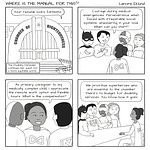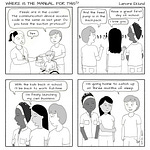
I have often said that having a disabled child feels like “falling through the looking glass” into a bizarro world where up is down and down is up.
One of the many odds things that happen in Special Needs World is you get told not to save for your child’s future: not to set up any bank accounts in their name and not even to open a college savings account.
Why?
Because, in America, government benefits are often tied to being very, extremely poor… or at least appearing so on paper. The Social Security Administration’s benefits for disabled children are very difficult to get and have an asset limit of just $2,000 per individual ($3,000 for a couple). If you have just $1 more than that in your bank accounts, your child cannot qualify for Supplemental Security Income (SSI).
Unless, of course, you put the money in a special box.
The way for parents of disabled children to put money in a special box is to get an ABLE account. This stands for Achieving a Better Life Experience and they are known under the tax code as 529(a) accounts — yep, kinda like college savings plans.
But what are ABLE accounts and why should a parent get one?
I have to admit, I was confused for a long time. Even after talking to a finance professional, even after I got one for my son, I still wasn’t clear on the benefits. I just sort of trusted them that this was the right thing to do.
That all changed recently when I caught up with an old friend. Formerly of the Statesman Journal, Kaellen Hessel-Owens now works in communications for the Oregon State Treasury, home of one of the first ABLE programs in the nation. Just like me before I had my kids, Hessel-Owens initially wasn’t aware of how bizarre the American disability benefits system is.
“I had no idea about the problems with asset limits until I started working at Treasury and the injustice of it all struck me,” she said. “I was like: ‘You’re making people do what?’ It was unbelievable.”
So when an opportunity came up to work under Oregon’s ABLE program, Hessel-Owens jumped at the chance. As of June 30, there are more than $53 million in assets under 5,487 such accounts in the state. The state pulls in about $30,000 a month in fees for those accounts, which goes towards the program’s administration, including the contract with Sumday, who manages the accounts. (Nationwide, there is more than $1 billion in ABLE accounts from 100,000 holders, according to the National Disability Institute.)
The vast majority of Oregon’s accounts are owned by adults; just 14 percent of the state’s account holders are under 19. Hessel-Owens wants to change that.
“There’s so many different ways that I think it could benefit families,” she said.
Read more: What you need to know about Social Security's benefits for disabled children
So: if you are a parent to a disabled child why would you want one? After all, the tax advantages are only on the interest. It’s not like a Health Spending Account, where you can put in pre-tax dollars. If you need special equipment TODAY for your kid, why would you put that money in that account?
First of all, if $16,000 a year is the difference between your child qualifying for Supplemental Security Income or not, this is a great way to shelter those assets. SSI is up to $794 per month.
Secondly, if you want to have any sort of savings for their future — what you might put away for a college education or down payment on an accessible house — an ABLE account is one of the only ways to save in their name in a way that preserves their ability to qualify for SSI and Medicaid after they become an adult. Otherwise, your child will have to pay out the nose until they are poor enough to qualify.
Third, ABLE accounts have a special pre-paid debit card that attaches to the account to help teach independent financial management. That means that as a parent you can authorize your teen or adult dependent a certain amount of money per week. You can even narrow down the limits to only spending certain amounts at certain places, such as $50 at GameStop instead of $1,000 like my kids would….
“We all have issues with impulse control,” Hessel-Owens said. “For some people with disabilities that is an even stronger barrier to using their money. This can help them stay on track with the goals they’re setting for themselves.”
And finally, you might live in a state like Oregon which gives a tax credit to people who put money towards the account. That’s right: free money! This applies to any Oregon resident, so grandma or neighbor or auntie can deposit money into your child’s account and get back up to $300 of it. (There are income tiers so check this chart.)
Once you have an account, what can you spend it on? The Internal Revenue Service has taken a pretty hands off approach on this one. The money should be spent on “qualified disability expenses,” but there’s no exclusion list, according to Hessel-Owens.
“It’s incredibly broad. You could fit most thing under that list,” Hessel-Owens says. Stuff like housing, education, transportation, job training, personal services and medical costs — all of that counts.
Read more: Special Needs World: The web of bureaucracy that ensnares parents of disabled children
What else do you need to know about ABLE accounts?
The accounts are limited to people diagnosed with a disability before turning 26. (Some U.S. Senators want to change that to 46.)
Every state but Idaho, the Dakotas and Wisconsin offer them. Most, like Oregon’s, accept account holders from any state. (Oregon’s national program is called ABLE for All.)
You can only have one account per person. That’s a nationwide restriction.
Each state’s program offers different fees, terms and investment vehicles. Check this site to compare: https://www.ablenrc.org/select-a-state-program/
ABLE account annual contribution limits are tied to the gift tax exclusion. So this year’s limit is $16,000 — the same amount someone can gift without incurring a tax penalty.
The max you can have in an account is $100,000 before it starts to affect SSI eligibility.
Contributions are halted when the account balance is more than $400,000.
If your child is old enough or able enough to work, they can additionally save money in what’s called an ABLE to Work contribution. That amount is tied to the federal poverty limit, currently $12,880.
To set up an account, all you typically need is about 15 minutes, a tax ID number and a bank account where funding is coming from.
Sounds pretty good right? But there is a downside. If you choose one of the investment options, there is risk involved. Choosing the aggressive plan is recommended if your children are young, and with the stock market in a downturn, now could be a good time to buy.
I started my son’s account when Oregon started allowing paid parent caregivers in 2021. If you’ve paid attention to the stock market, you’ll notice that that was not ideal timing to make an aggressive investment and we have actually lost money.
But, I consider investing as “betting on rich people” and I swear that, somehow, they always win in the end. We regular folks might as well take advantage of their strategies like tax shelters and investments.
Medical Motherhood’s news round up
Snippets of news and opinion from outlets around the world. Click the links for the full story.
• From the Wall Street Journal: “Caring for Family Doesn’t Have to Be Unpaid Work”
An estimated 48 million Americans provide care without pay to an adult family member or friend, according to Caregiving in the U.S. 2020, a report by AARP and the National Alliance for Caregiving.
Many of these family caregivers assumed the role during the pandemic, as private caregivers left what is a demanding and low-paying profession. Often, these caregivers—the majority of whom are women—have to leave their own job, creating a financial strain on their households.
Interest in providing financial support for family caregivers, including compensation, is growing due to the workforce crisis, long Covid and the growing gap between the number of people needing care and those available to provide it, says Lance Robertson, a director in healthcare for the consulting firm Guidehouse, and former U.S. assistant secretary for aging. “Family members are right there. They’re equipped and capable. If we lose them, it will worsen the workforce crisis,” he says.
Many family caregivers are eligible for hourly wages, most often through state Medicaid plans, but don’t know it exists or how to navigate the often complicated process. Coverage, eligibility and benefits vary by state and sometimes by county. Some states require family members to take training courses. Others won’t pay a spouse or legal guardian or a family member, who lives in the same house. Hourly pay is often based on the average local wage for a home care aide. The median hourly wage for home health and personal care aides is about $14 an hour.
• From former presidential candidate and current U.S. Transportation Secretary Pete Buttigieg (via Medium): “One year in, parenting has taught us about vulnerability and gratitude”
Most parents don’t start off expecting to be among the ones who know their way around a children’s hospital. But suddenly it’s you. Soon the hospital was our new home base, and in different combinations, through days and sleepless nights, the two of us cycled between Gus’ bedside in the ICU room, the cafeteria with its six-cheese lasagna special, and the nearby hotel with Penelope’s bassinet, endlessly grateful to the friends and family who helped us cover down.
Parenting is lots of things, and one of those things is terror. You watch your infant, sedated and surrounded by wires and tubes and monitors and medical personnel coming and going constantly, and wonder how we could live in a universe where a few weeks could be all that a child gets on this earth. (In one dark moment, I wondered if my weeks of parental leave would amount to the entirety of my time with our son, this beautiful infant whose face I had seen for the first time just weeks earlier and whose life had now come to matter to me as much as my own.) I prayed. I looked for meaning in tiny fluctuations in the vital signs on the monitors. I thought of my father, whose last days played out on a ventilator in an ICU room like this as he lost his battle with lcancer, though Chasten repeatedly reminded me that this was a completely different situation. We tried not to hassle the medical staff with our million questions which were really just one question. And they patiently repeated the one honest answer, which was that with this kind of virus, the only way you know it’s getting better is when it’s stopped getting worse.
• From TODAY.com (opinion): “My son will need 24/7 care for the rest of his life. So, I bought him a farm”
(Note: Jessica Ronne was the subject of a documentary Medical Motherhood featured in April called Unseen: How We’re Failing Parent Caregivers and Why It Matters.)
As time progressed, we moved away from rural Tennessee in search of more resources and support, which led us back to my hometown in Michigan, where Lucas recently celebrated his 18th birthday. This is when everything changed again. Now that Lucas was officially an adult, we realized how few long-term assisted living facilities were available for profoundly disabled individuals who would require 24/7 care for the rest of their lives. This is not just our reality; thousands are on waiting lists for assisted living.
Adults with intellectual and developmental disabilities often are placed in long-term housing when their parents die or become terminally ill. Imagine the trauma of losing a beloved caregiver and then being forced to leave the only home you’ve ever known. Imagine how confusing it would be to be transported hours away to a facility that may be poorly regulated and may offer limited care. It’s not an ideal scenario — so, we expanded our mission statement at The Lucas Project once again. We decided that, in addition to providing respite and recognition, we also would offer residential support to special needs families.
My husband and I recently closed on our first property due to the generosity of an anonymous investor who offered to front the money for a short-term loan. We’ve affectionately named the property Hope Farm, and it will provide housing and long-term care for six disabled adults — hopefully by next summer if we can maneuver through the bureaucratic red tape, which can be overwhelming with Medicaid dollars involved! We also hope to turn the big white barn on the property into a respite center. Our desire is to offer weekend and after-school care to the special needs community in West Michigan. It’s a beautiful property full of potential, but it needs a lot of work! But — it won’t be the hardest thing we’ve ever accomplished, and we have faith in the generosity of humanity to help us through.
Medical Motherhood brings you quality news and information for raising disabled and neurodivergent children. Get it delivered to your inbox each Sunday morning or give a gift subscription. Subscriptions are free, with optional tiers of support. Thank you to our paid subscribers!
Follow Medical Motherhood on Facebook, Twitter, TikTok, or Instagram. The podcast is also available in your feeds on Spotify and Apple Podcasts. Visit the Medical Motherhood merchandise store.
Do you have a story to share or an injustice that needs investigation? Tell me about it and it may become a future issue.












